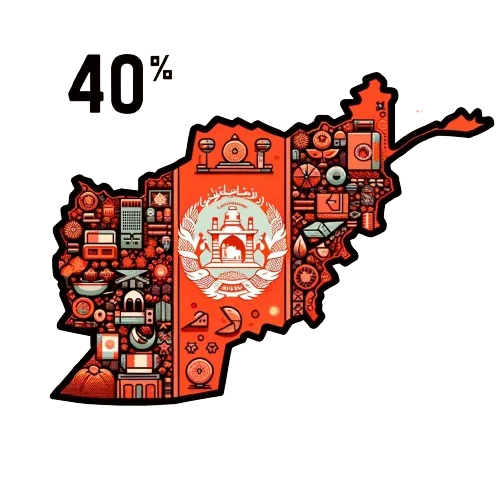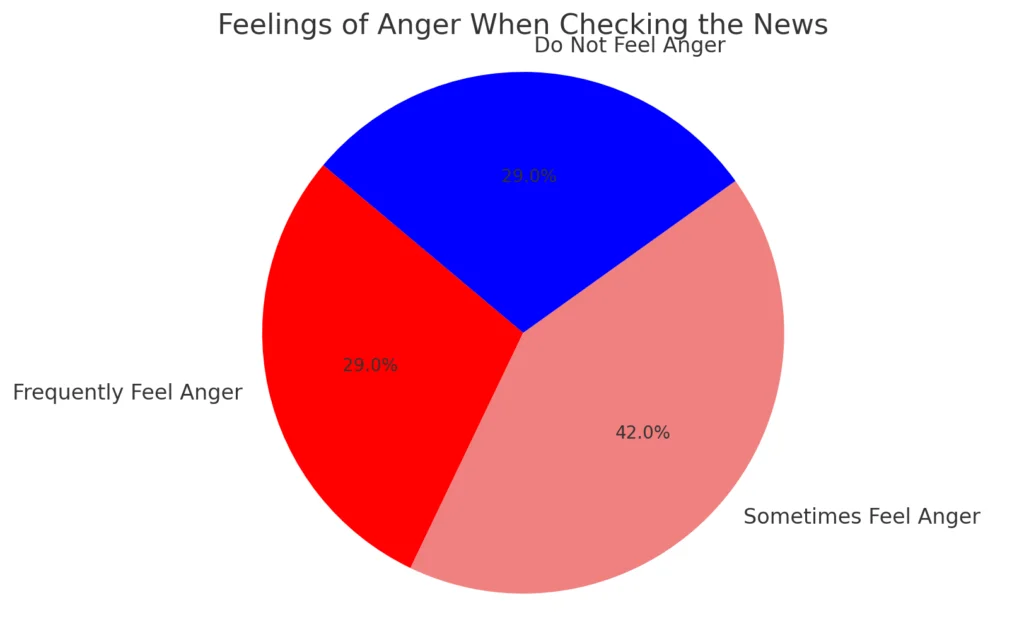Welcome to our hub featuring statistics on anger from various publications, research papers, and surveys, including causes of anger.
We cover global perspectives, the world’s angriest countries, road rage, police officers and more.
The statistics show relationships and results (positive and negative) graphs and other figures.
Regular updates will keep this information relevant, and you can use this resource and the anger statistics it presents in your work.
Explore facts on anger in society through data.
You are welcome to cite and utilize this page, images, and figures featured.
World’s Angriest Countries

Global Emotions Report, reflecting on the sentiments of populations worldwide. Here are the countries that reported the most anger on the Gallup Poll:

Northern Cyprus: Tops the list with 52% of respondents affirming they felt anger during a significant part of the previous day. This sentiment may be influenced by ongoing tensions due to its unique political status and recognition issues.
Armenia: Now at 50%, continues to experience high levels of public anger. Historical conflicts, such as the prolonged tensions over Nagorno-Karabakh, and recent political shifts may contribute to these feelings.


Iraq: With 46% of respondents reporting anger, remains a country where public sentiment is heavily affected by its long-standing challenges with war, internal political strife, and efforts at rebuilding a nation marred by conflict.
Jordan: Sees 43% of its respondents reporting anger. Jordan’s strategic importance in the region, along with economic and refugee pressures, may play a role in the emotional state of its citizens.


Morocco: At 41%, finds itself among the top five, where socio-economic challenges, such as unemployment and social disparities, could be factors influencing the public mood.
Uganda: With 41% of individuals expressing anger, the sentiment could be reflective of the country’s complex social and political fabric, which includes challenges such as human rights issues and governance concerns.


Afghanistan: Shows that 40% of the respondents experienced anger. Despite a change in regime, the country’s turbulent history continues to impact its people’s emotions, with ongoing security concerns and societal upheaval.
Türkiye (Turkey): Reports that 39% of people felt anger. Türkiye’s position at the crossroads of East and West brings unique challenges, including political tensions and economic pressures that may contribute to public sentiment.


Libya: Also has 39% of its population reporting anger, a likely reflection of the ongoing instability and political fragmentation since the fall of its long-time leader, which has led to periods of civil war and unrest.
Iran: Matches Libya with 39% of respondents feeling anger, amidst a backdrop of international sanctions, domestic economic struggles, and social unrest stirred by political and cultural issues.

Here is the list of the countries with the lowest reported levels of anger, according to the latest Global Emotions Report:

- Finland: 6% Yes / 94% No – Finland’s low anger incidence is a reflection of its culture that fosters trust and community, supported by social policies that ensure a high standard of living and reduce daily stress.
- Vietnam: 7% Yes / 93% No – In Vietnam, a collective culture prioritizing social harmony, combined with economic vitality, contributes to the emotional well-being of its citizens, with only a small minority experiencing frequent anger.
- Norway: 8% Yes / 91% No – Norway’s culture of equality and social trust, backed by a strong economy, contributes to only 8% of its population reporting anger, showcasing the success of its social model.
- Iceland: 8% Yes / 92% No – With 8% reporting anger, Iceland’s strong social bonds and trust in institutions, along with a high living standard, play significant roles in maintaining a peaceful and contented society.
- Estonia: 8% Yes / 92% No – Estonia’s innovative digital governance and economic progress have led to a society where only a small fraction reports anger, reflecting the efficiency and comfort of everyday life.
Source:
https://news.gallup.com/interactives/248240/global-emotions.aspx
Anger on the Road (Road Rage)

Nearly 80 percent of drivers expressed significant anger, aggression, or road rage behind the wheel at least once in the past year.
Approximately eight million U.S. drivers engaged in extreme examples of road rage, including purposefully ramming another vehicle or getting out of the car to confront another driver.
Purposefully tailgating: 51 percent (104 million drivers)

Yelling at another driver: 47 percent (95 million drivers)

Honking to show annoyance or anger: 45 percent (91 million drivers)
Making angry gestures: 33 percent (67 million drivers)
Trying to block another vehicle from changing lanes: 24 percent (49 million drivers)

Cutting off another vehicle on purpose: 12 percent (24 million drivers)
Getting out of the vehicle to confront another driver: 4 percent (7.6 million drivers)
Bumping or ramming another vehicle on purpose: 3 percent (5.7 million drivers)
Source:
https://newsroom.aaa.com/2022/12/going-in-reverse-dangerous-driving-behaviors-rise/
Stress and Anger
Nearly half of adults (49%) report their behavior has been negatively affected by increased stress, with symptoms that may relate to anger and rage.
The specific behaviors reported include:
Increased tension in their bodies (21%)
“Snapping” or getting angry very quickly (20%)
Screaming or yelling at a loved one (17%)

Gen Z adults report the highest levels of stress in comparison to other generations:
Gen Z (ages 18-23) average stress level at 6.1 out of 10
https://www.apa.org/news/press/releases/stress/2020/report-october
Anger Prevalence Insights
In the U.S., 7.8% of adults grapple with intense or uncontrolled anger.
Over half of those facing anger challenges are men, at 52.26%.

Young adults between 18-29 are significantly impacted, with a 22.23% chance of intense anger issues.
Native Americans are more likely to experience anger, with an odds ratio of 1.40.
A staggering 87.16% of individuals with anger issues also have a psychiatric diagnosis.
Among those with anger problems, 72.23% face an Axis I disorder, while 73.46% struggle with a personality disorder.
Substance use disorder is a common co-occurrence in 43.67% of those with anger issues, and mood disorders in 34.82%.
Bipolar disorder is prevalent in 19.71% of individuals with significant anger challenges.
Childhood behavioral problems in parents heighten the odds of anger in their offspring, with an odds ratio of 3.31.
A concerning 44.91% of adults with anger issues report experiencing verbal abuse or emotional neglect during childhood.
Small triggers lead to uncontrollable anger in 4.26% of the population.
Losing control due to anger outbursts is a reality for 4.29% of people.
Aggressive behaviors like hitting or throwing objects in anger affect 4.35%.
The insights come from a comprehensive study involving more than 34,000 adults.

The prevalence of anger issues scales with the number of symptoms: one issue stands at 4.17%, two at 2.17%, and all three at 1.46%.
Source Retrieved:
Okuda M, Picazo J, Olfson M, Hasin DS, Liu SM, Bernardi S, Blanco C. Prevalence and correlates of anger in the community: results from a national survey. CNS Spectr. 2015 Apr;20(2):130-9. doi: 10.1017/S1092852914000182. PMID: 25831968; PMCID: PMC4384185.
Americans’ Perspectives on Increasing Anger (Poll)

- 84% of Americans surveyed believe people are angrier today compared to a generation ago.
- 42% of respondents reported feeling angrier in the past year than previously.
- 29% of people frequently feel anger when checking the news, while 42% sometimes feel anger.
- Older individuals, 65 and up, are less likely to feel anger when checking the news, with only 21% admitting to it.
- Regarding social media usage, 7% of people 65 and above often feel anger, versus 18% under 35.
- When expressing anger, 90% of respondents agree people are more likely to do so on social media than in person.
- The poll surveyed 3,004 people during early November 2018.
- The margin of error for the survey is +/- 1.8 percentage points.
- Nearly 7 in 10 respondents view anger as a negative emotion, but 31% do not agree with that sentiment.
Author: Scott Hensley
Article Title: Poll: Americans Say We’re Angrier Than A Generation Ago
Date: June 26, 2019
Publishing Organization: NPR
Study’s Geographical Focus: United States
URL: https://www.npr.org/sections/health-shots/2019/06/26/735757156/poll-americans-say-were-angrier-than-a-generation-ago
https://web.archive.org/web/20190626211304/https://www.ibm.com/downloads/cas/2YQ8NLD5
Reported Anger Statistics and its Pervasiveness
- 32% of adults have a close friend or family member with anger issues; higher among women (35%) and young people (36%).
- 28% worry about their anger levels, with 31% of men expressing this concern more than women.
- 12% report difficulties in controlling their own anger, with a higher rate among women (13%) and the 18-24 age group (20%).
- 20% have ended a relationship due to someone’s anger, with 26% being women.
- 64% perceive an increase in general anger in society, with larger agreement among older individuals.
- Only 13% of those recognizing their anger issues have sought help.
- 58% would not know where to seek help for anger management, 61% of which are women.
- A strong majority, 84%, thinks people should seek help for anger problems.
- Among those not seeking help, 42% would not know where to turn.
- Regional disparities note that 17% in Scotland report difficulty in anger control versus 9-13% in other regions.
- Scotland’s rate for terminating relationships due to anger stands at 24%, higher than in England and Wales (18-20%).
- Individuals in social grade C2DE are more likely to encourage seeking help for anger issues (86%).
The study’s geographical scope covered various regions of Great Britain with a total survey sample size of 1,974 adults aged 18+. The research involved a questionnaire and was conducted by YouGov for The Mental Health Foundation. The title of the publication is “Boiling Point Problem anger and what we can do about it”.
https://www.mentalhealth.org.uk/explore-mental-health/publications/boiling-point
Customer Anger and Rage
66% of households experienced a product or service problem in the past 12 months.
Nearly 2/3 of those with a problem experienced customer rage.
Over half of complainants received nothing when they complained, contributing to customer rage.
17% sought to raise public awareness of their experience, driven by anger and frustration.
14% posted their complaint at least once on social media, demonstrating the tendency to express rage online.
Dissatisfied complainants tell twice as many people about their negative experiences compared to satisfied customers, highlighting the impact of rage on negative word-of-mouth.
55% expect a company response to a complaint on social media, with almost half not receiving a response, further increasing feelings of anger and neglect.
These statistics highlight the extent of customer anger and rage when their complaints are mishandled or ignored, and the various ways they express and share their dissatisfaction.
Anger Trends Among Military Personnel

- Overall, 17.3% of respondents reported problematic anger.
- Among those with problematic anger:
- 24.3% endorsed “I often find myself getting angry at people or situations.”
- 22.0% endorsed “When I get angry, I get really mad.”
- 14.8% endorsed “When I get angry, I stay angry.”
- 10.8% endorsed “When I get angry at someone, I want to hit or clobber the person.”
- 9.1% endorsed “My anger prevents me from getting along with people as well as I’d like to.”
Adjusted Odds Ratios (AORs) for factors associated with problematic anger:
- Active duty service members: AOR = 1.28
- Separation from military service: AOR = 1.45
- Deployment with medium/high combat severity: AOR = 1.34
- Reporting 3 or more childhood traumatic experiences: AOR = 2.70
- “Bothered a lot” by financial worries: AOR = 1.94
- Comorbid PTSD and MDD: AOR = 4.43
- PTSD only: AOR = 3.52
- Problem drinking: AOR = 1.46
Population Attributable Risk Percent (PAR%):
- Reduction of problematic anger could be achieved by addressing:
- Financial problems: PAR% = 14.0%
- PTSD only: PAR% = 12.0%
- Increase in positive perspective: potential PAR% reduction = 12.1%
- Increase in self-mastery: potential PAR% reduction = 9.3%
Other associations:
- Each unit increase in positive perspective led to a 28% decrease in odds for problematic anger.
- Each one-unit increase in self-mastery score led to a 16% decrease in odds for problematic anger.
https://bmcpublichealth.biomedcentral.com/articles/10.1186/s12889-020-09206-2
Examining Police Anger and Frustration
Exploring the impact of job-related anger and frustration on police officers’ attitudes and behaviors:
About one-in-five police officers nationally (21%) say their job nearly always or often makes them feel angry and frustrated.
Among the officers surveyed, 22% say they nearly always (3%) or often (19%) feel angry.
Officers who frequently feel angry and frustrated are twice as likely as all other police to say officers have reason to distrust most people (46% vs. 23%).
Frequently angry and frustrated officers are more likely to have physically struggled or fought with a suspect in the past month (44% vs. 30%) compared to their colleagues.
Officers who frequently feel angry and frustrated have been verbally abused by a citizen in the past month at a higher rate (79% vs. 64%) compared to those who do not often feel this way.
Frequently angry and frustrated officers are roughly twice as likely as those who are not frequently angry or frustrated to agree that police have reason to be distrustful of most citizens (46% vs. 21%).
About eight-in-ten angry and frustrated officers (77%) agree that they have become more callous toward people since taking the job, compared to 42% of officers who say they are not frequently angry or frustrated.
Frequently angry and frustrated officers are more likely than other police to agree that some people can only be brought to reason the hard, physical way (56%), while only 37% of officers who are not frequently angry or frustrated agree with this view.
Source:










